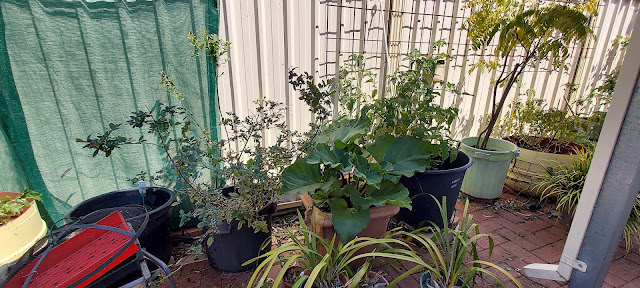Spring has arrived and we are as busy as can be, whenever the weather is good. With drier weather, and occasional warm days, we are feeling the need to get stuck into some jobs which always come around in spring. With our Australian economy dealing with global energy spikes and the poor farmers of the eastern states being flooded -some for the second or third time this year, our fruit and vegetable prices have gone up by 14% this year.
DH renewed the oil on the outdoor furniture. This is a preservative and it gives us a chance to make sure the furniture can stand another year of outdoor living.
The garden is busy! We flushed the reticulation pipes and repaired the spots that had got broken since it was last used. The reticulation is now on again, two days a week. Our gardens have to be hardy in this climate! I water pots if they need it, and about once a week I water the non-irrigated front verge if anything is looking distressed. The plants out there are chosen for their ability to survive once they have had their first summer in the ground.
As the annuals in the front garden start to dry off, I am planting perennials like pelargoniums in their place. I have dug up some iris corms and replanted them in other spots. There is warrigal greens ( a native edible) growing as a ground cover in the front garden too. This garden is both a food garden and an ornamental one. We have a pomegranate, olive, mulberry, lemon and two grapevines here. Tomatoes come up in the compost and I let them grow. Maybe in the future I will be wanting to grow more food out here too. Pumpkins could ramble along under the trees.
As herbs and flowers are in their prime now, I am drying some and also making sure I leave some to go to seed. I have coriander hanging up to dry, to harvest the seeds for my curries. Lavender is drying to perfume new heat packs which I will stuff with rice. Mint is known as a good help for digestion and can be good for the brain too, I understand. These may be small harvests, but they are very welcome in my kitchen. Calendula petals can be in a healing salve or tea, or added to risotto.
I find herbs to be a very worthwhile group of plants to grow. They are expensive to buy in the shops when you just need a bit for a recipe, but most are very hardy in the garden. Once you have planted them you have fresh herbs for a long time, and they really make a difference to the flavour of the dish you are making. Many of them contain important nutrients too. Herbs I grow include Basil, Borage, Calendula, Chilli, Chives, Coriander, Curry Leaf, Lavender, Lemon Balm, Lemon Grass, Mint (four varieties), Parsley, Rosemary, Sage, Thyme -2 varieties, Verbeena. Most of these grow easily from cuttings so I can give them away for other gardeners to enjoy.
I have planted tomatoes in all sorts of places and I am experimenting with various kinds of supports and feeding regimes. Nearly everyone says that you should not 'over feed' tomatoes in case you just get leaves and not fruit. Jackie French, the Australian gardener, novelist and all round nice person, says the opposite, so I am trying that out in one pot by adding compost and lots of mulch around a cherry tomato plant.
There is a mulberry tree on the verge near a park in our suburb. DH brought home half a kilo of ripe berries from his walk today! This is very welcome, as my new FODMAP friendly diet requires me to eliminate some common fruits, but the good news is that berries are fine! My grandson had his first ever mulberry today, and announced that he loved them- and why not? As an urban forager, we know that the polite thing to do is to always leave some for the next person who comes along. Meanwhile our own mulberries are weeks away from being ripe.
Inspiration for hard times: simple ways to garden without spending lots of money
Make a wild food map of your area here
Food insecurity in Australia -read here









No comments:
Post a Comment